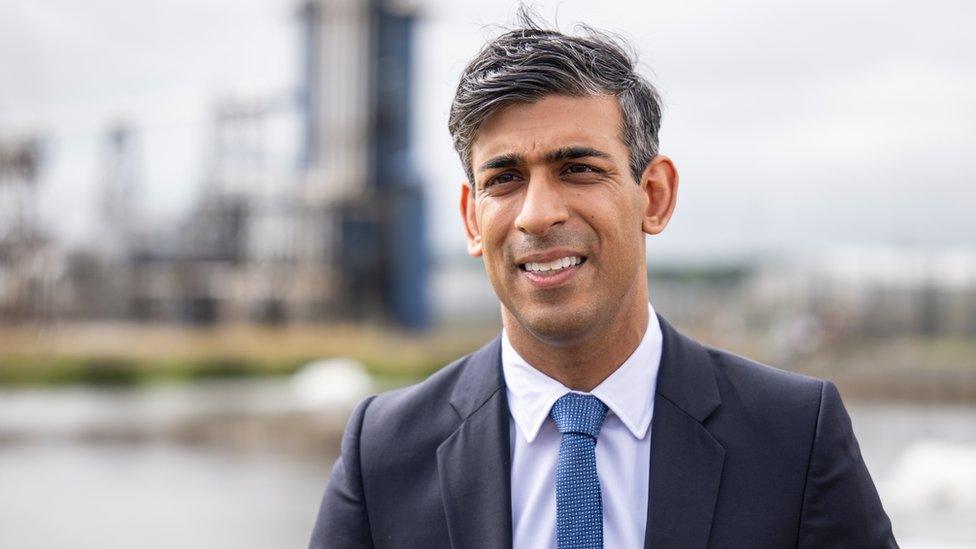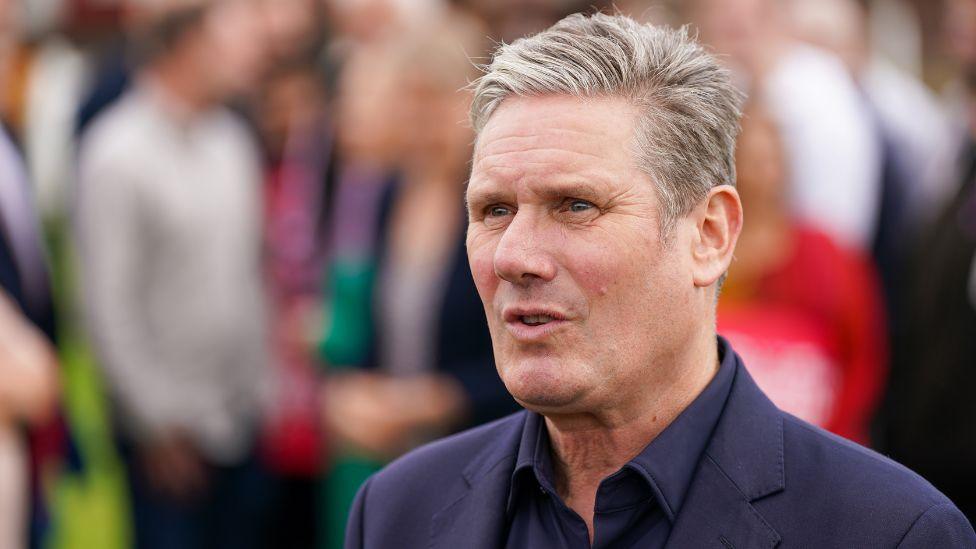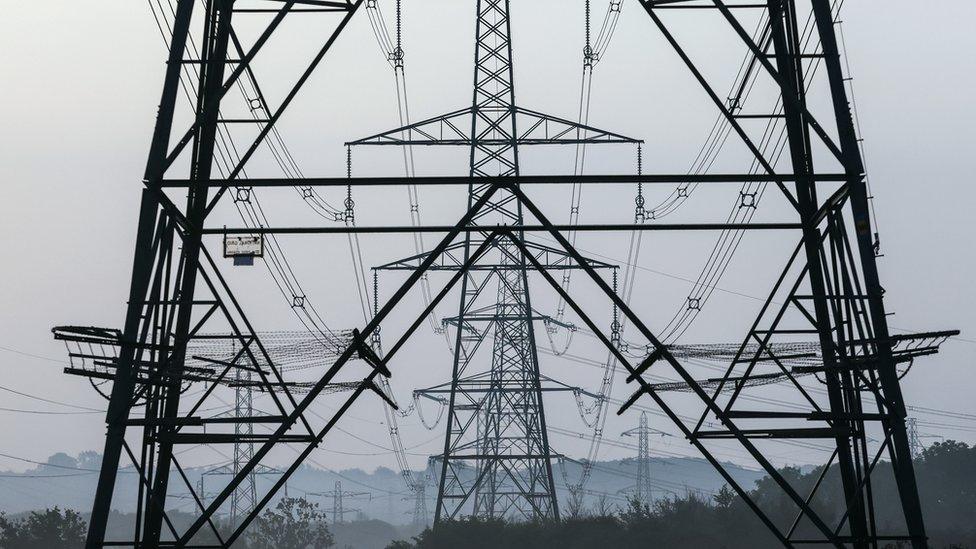The great energy transition: Who pays the bill?
- Published

The prime minister's support for new oil and gas licences has sparked criticism
Energy is taking a higher profile in the battle for power at Westminster, which could bring a coherent policy, or the pretence that the replacement of fossil fuels with renewables can be done painlessly.
Rishi Sunak has set out a plan for more drilling and more carbon capture and storage, while seeking to make energy a wedge issue with which to define his Labour opponents.
Carbon capture is neither a magic solution nor cheap. And without addressing continued demand for oil and gas, arguing over its supply from UK waters leaves out an important part of the equation.
A policy on energy: it's been one of the most elusive concepts in British government, and for decades. But we might be about to get one.
Whether it's the right one, that's another question. But at least it would be a plan.
Since the 1970s, while continuing to burn a lot of coal for its power needs, the UK relied on the North Sea.
While other European nations saw the Arab oil embargo and price hike of 1973 as a warning, Britain felt its offshore bonanza gave it a free pass. And a lot of tax revenue, to finance a fundamental reshaping of the economy, along with tax cuts.
That source of gas fuelled the adoption of central heating, which now heats around 85% of homes. Of the others, off the gas grid, there's oil.
Britain lags its continental neighbours in adoption of other options, led by air source heat pumps, while potential adopters wait for their efficiency and cost to optimise. Geothermal and district heating also lag.
When government ministers boast of reducing emissions by more than other countries, they're referring to a baseline of 1990. That means that a major contributor to Scotland's reduced emissions was the closure of the Ravenscraig steel works, two years later.
Our carbon footprint from heavy industry was being sharply reduced by the decline of manufacturing, making the subsequent emission numbers look good, while the impact of new industries in distant and globalising nations, such as China, no longer counted against us. Closure of coal-fired power stations at Longannet and Cockenzie followed much later, and contributed further to that sense of emissions progress.
Decisions on replacing nuclear power capacity were put off as very expensive and politically difficult, leaving a large gap as reactors were retired, along with a loss of skills in Britain's nuclear fleet. Britain had to turn to China and France for the current wave of investment in the technology.
On or offshore?
There have been piecemeal developments through the years. When offshore wind took off, Britain became the world leader.
That was after giving away a lead in developing wind turbine technology. And it was partly because England effectively shut down development of onshore wind, because it, too, was politically difficult and remains so.
But even at the vast scale of offshore deployment, with lots more to come, what has been lacking has been a narrative, with which to carry public opinion on the costs and benefits of planning decades ahead.
That may be changing. A report published on Friday highlighted the lack of joined-up thinking, planning and story-telling about the re-orientation of the electricity grid, away from big plants near cities towards renewable energy out at sea.
These are far from cities and most customers, and require long grid connections.
We reported on the £10bn plan for the north of Scotland, which is meeting opposition or at least concern about the harm done to Highland and north-east landscapes.
The subsequent report said those who lived near such new routes should be compensated.
There is ambiguity about who decides. The Scottish government cannot require such payments, but it can use the planning system to create such an expectation. Westminster has more powers to make it explicit.
On the same day as that report on the Highland pylon pile-on, Rishi Sunak touched down in Aberdeen to make two big announcements on energy - one on carbon capture and storage (CCS) extending to the north-east, after several false starts.
The other was to accelerate development of oil and gas reserves.
Both were highly political, and it could be that politics will drive this into a more coherent plan by the time we get to the Westminster election due in the next 17 months.

Rishi Sunak announced support for new oil and gas licences during a visit to the north east
CCS is controversial with some, because it is a highly industrial and expensive solution to the carbon emissions challenge.
Although the industry hopes to bring down the cost of capture from around £90 per tonne, it aims to reduce that to below £40.
But in doing so, it's a highly industrial answer to the challenge.
The opposition to it is not the concept, but mistrust of industry motives. It provides a means for the oil and gas industry to keep drilling.
But it's not just that industry with that need. If it works at scale, it can allows generators to continue making electricity from gas, oil and even coal. It allows petrochemicals and refining to continue, while mitigating emissions.
It allows for "blue" hydrogen, derived from methane, in that it means the carbon by-product can be captured. The UK plans as much as 10 gigawatts of blue hydrogen production - nearly twice Scotland's peak demand for electricity.
Steel manufacturing remains necessary for many other manufacturers, including those who make towers for wind turbines, and CCS allows the steel to be "green".
One of the most important industries, with one of the biggest impacts, is cement.
Process heat and chemical reaction add up to 7% of global emissions. If it were a country, cement would be the third highest emitter. And modern construction of buildings and other infrastructure cannot avoid a heavy dependence on it, so "green cement" is important.
While the technology is proven, it is only at a small scale. Only around 40m tonnes of carbon are sequestered each year, in 30 plants built worldwide since the 1970s. The aim is to get to 8 billion tonnes by 2050.

The St Fergus Gas Terminal has been earmarked as a carbon capture hub
Meanwhile, on oil and gas production, output has been on a downward trend since the start of the century. Production 23 years ago was close to 4.5 million barrels per day of oil or its gas equivalent. It fell below 1.5m barrels by 2013, when an upturn began, fuelled by a investment surge.
It is now back onto a downward path again, and the pace of that decline is for drilling firms to determine, with their investment decisions shaped by the licensing and tax regime controlled by the UK government and its North Sea Transition Authority.
The proposal to approve 100 licences for drilling is an unusual approach to developing the sector - not prioritising licences where the plans are justified, and ensuring they meet a check list of considerations, but setting a target number.
Boosting licences may not do as much to increase output as the windfall tax has achieved in harming it. The 75% tax on profits is not the problem for the industry so much as the unpredictability of UK tax take over the years.
While Conservative ministers have introduced that hazard into planning, Labour's poll ratings make the outlook less clear.
Sir Keir Starmer has said his party would honour approved licences, but would not issue more, and it wants to take more from windfall profits, which probably means it would reduce tax-free investment allowances.

Labour leader Sir Keir Starmer has taken a tougher stance on new oil and gas projects
Meanwhile, there is an increasing pace to the depletion rate of older oil and gas fields.
Offshore Energies UK (OEUK), which represents the sector, said there are 283 active UK fields, of which 180 will have ceased production within only seven years.
Without replacement, the rate of production will decline much faster, the trade body has warned.
Demand for oil and gas is not declining at the same pace. Their share of total energy sources is above three-quarters, and set to decline only slowly this decade.
While that remains the case, declining production makes the UK more dependent on net imports, so it is paying out more for energy.
It exports a lot, and imports a lot, but overall, OEUK has said UK production currently supplies 40% of UK oil demand and 67% of gas demand.
The output is sold on world markets, so in practice, the gain to the UK is in a lower import bill and jobs in the sector.
And while more output globally should reduce prices, none of the decisions being made about British output are at a scale expected to affect global prices significantly.
Who pays?
While the war in Ukraine and the effect of sanctions on Russia has roiled world markets and forced the UK to think more seriously about energy security, that domestic production is only protected for British use in emergencies more severe than the one we have had in recent months.
That is one of the reasons why energy choices have become more pressing. The other lies closer to home.
The cost of measures to reduce carbon emissions are getting closer to home. Some in politics want to argue that the transition from fossil fuels to renewables can only be sold if there are either no costs or some benefits.
Sir Dieter Helm, the energy guru, rubbished that notion in a BBC News interview following publication of Nick Winsor's report on grid connections.
But the battle over who pays for the transition, and how, has only just begun.
A majority of less than 500 in the Uxbridge by-election last month, explained by voter dislike of the Labour mayor's introduction of an extended congestion charge, seemed to persuade Conservatives that opposition to green measures was the route to re-election.
Rishi Sunak's former environment minister, Lord Zack Goldsmith, set out in harsh terms, as he resigned his post, the prime minister's lack of concern or priority for reaching net-zero emissions.
Mr Sunak appears to be the least motivated by those concerns of the past five Conservative prime ministers.
And with his announcements on CCS and becoming licensed to drill this week, the Tory leader has chosen to use this as a wedge issue to differentiate his party from Labour.
It is one of the paradoxes of politics - give an issue a high priority as a campaigning issue and you ensure more priority for it when in government, and that long-neglected energy policy could emerge.
But by sacrificing consensus, it is harder to plan long term.
- Published2 August 2023

- Published31 July 2023

- Published31 July 2023

